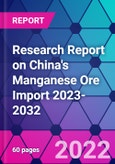Manganese is gradually becoming a more important raw material in lithium battery cathode materials. As the ""upgraded"" version of lithium iron phosphate, lithium manganese iron phosphate is a new type of cathode material obtained by adding manganese element to lithium iron phosphate.
With the rapid development of China's electric vehicle industry, the demand for manganese in China is rising. Due to the limited local production of manganese in China, China needs to import a large amount of manganese ore every year.
In 2021, China imported 29,949,600 tons of manganese ore (""manganese ore and its concentrate"", the same below), down 5.09% year-on-year, with an import value of US$4.902 billion, up 0.36% year-on-year. According to the publisher's analysis, from January to October 2022, China imported 24.8583 million tons of manganese ore, down 2.77% year-on-year, and the import value was US$4.911 billion, up 19.35% year-on-year. The main reason for the decline of China's manganese ore import in 2021-2022 is that COVID-19 has affected the plant's opening rate and made the international logistics become uncomfortable.
From 2018 to October 2022, the average price of China's manganese ore imports generally shows a trend of first decrease and then increase. From 2018 to 2020, the average price of China's manganese ore imports decreases continuously from US$210.52 per ton to US$154.79 per ton. According to the publisher's analysis, from 2021 to 2022, the average price of China's manganese ore import gradually increases, and the average price of China's manganese ore import from January to October 2022 is US$197.57 per ton, an increase of 22.75% year-on-year.
In 2021, China imported manganese ore from 34 countries in total. According to the publisher's analysis, South Africa, Australia, Gabon, Ghana and Brazil are the main sources of manganese ore imports in China by import volume. Among them, South Africa is the largest source of manganese ore import in China. In 2021, China imports 13.954 million tons of manganese ore from South Africa, accounting for 46.59% of the total import volume, and the import value of US$2.102 billion, accounting for 42.89% of the total import value.
China is a major consumer and importer of manganese ore in the world. However, China's manganese ore resource reserves are small, and the manganese ore deposits are small in size, low in grade and complex in composition, so the Chinese market is highly dependent on manganese ore imports. The publisher expects that with the rising production of new energy vehicles in China, the demand for power lithium batteries is increasing, and the import volume of manganese ore in China will continue to rise in 2023-2032.
Topics covered:
- China's Manganese Ore Import Status and Major Sources in 2018-2022
- What is the Impact of COVID-19 on China's Manganese Ore Import?
- Which Companies are the Major Players in China's Manganese Ore Import Market and What are their Competitive Benchmarks?
- Key Drivers and Market Opportunities in China's Manganese Ore Import
- What are the Key Drivers, Challenges, and Opportunities for China's Manganese Ore Import during 2023-2032?
- What is the Expected Revenue of China's Manganese Ore Import during 2023-2032?
- What are the Strategies Adopted by the Key Players in the Market to Increase Their Market Share in the Industry?
- What are the Competitive Advantages of the Major Players in China's Manganese Ore Import Market?
- Which Segment of China's Manganese Ore Import is Expected to Dominate the Market in 2032?
- What are the Major Adverse Factors Facing China's Manganese Ore Import?
Table of Contents
Methodology
Background research defines the range of products and industries, which proposes the key points of the research. Proper classification will help clients understand the industry and products in the report.
Secondhand material research is a necessary way to push the project into fast progress. The analyst always chooses the data source carefully. Most secondhand data they quote is sourced from an authority in a specific industry or public data source from governments, industrial associations, etc. For some new or niche fields, they also "double-check" data sources and logics before they show them to clients.
Primary research is the key to solve questions, which largely influence the research outputs. The analyst may use methods like mathematics, logical reasoning, scenario thinking, to confirm key data and make the data credible.
The data model is an important analysis method. Calculating through data models with different factors weights can guarantee the outputs objective.
The analyst optimizes the following methods and steps in executing research projects and also forms many special information gathering and processing methods.
1. Analyze the life cycle of the industry to understand the development phase and space.
2. Grasp the key indexes evaluating the market to position clients in the market and formulate development plans
3. Economic, political, social and cultural factors
4. Competitors like a mirror that reflects the overall market and also market differences.
5. Inside and outside the industry, upstream and downstream of the industry chain, show inner competitions
6. Proper estimation of the future is good guidance for strategic planning.

LOADING...








